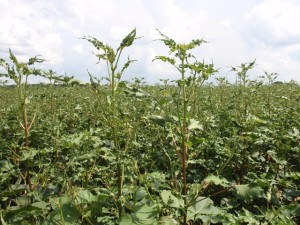Pesticide drift is a chronic concern for anyone who applies herbicides, insecticides, fungicides and any other compound meant to control or kill a problem specie. These photographs show the effects of 2,4-DB drift from a peanut field to a cotton field across the road. Although the damage looks terrible, the plant will grow out of it.
However, according to Dr. Dale Monks, the grower should expect a yield decrease. The loss of production equates to an economic loss, and a reduction of the bottom line. Cotton is extremely sensitive to 2,4-D. There are two ways that the pesticide can drift: Volatilization and Physical.
Volatilization occurs when the pesticide changes from a liquid to a gas. The vapor can then move large distances with the wind currents. This type of drift can cause severe injury to cotton several miles from the application site. The old ‘ester’ formulations of 2,4-D were particularly vulnerable to volatilization. Today only 2,4-D amine and what are called low-volatile ester 2,4-D’s are sold. Of these the amines are the least vulnerable to volatilization followed by the ‘isooctyl’ esters and last the ‘butoxyethenol’ esters.
To minimize the risk associated with volatilization only use 2,4-D amine formulations or dicamba when cotton is growing nearby. 2,4-D amines are only slightly more volatile than dicamba under normal conditions. When possible avoid application when temperatures are above 90°F.

Physical drift, the most common type of drift, can occur with any herbicide and is the most common type of drift. Many variables influence drift, but wind speed, boom height, and distance downwind to susceptible vegetation, have the greatest effect on drift. When at all possible avoid herbicide application when the wind speed is greater than 10 mph and keep spray boom as close to the target as possible.
Droplet size is imperative in controlling drift. The smaller the droplet the greater the risk of
drift. The production of small droplets can be controlled by:
a. Use as large an orifice size as you can get by with.
b. Increase water volume.
c. Use lowest possible pressure setting within your nozzle’s ideal range to create larger droplets.
d. Nozzle selection.
Be aware of thermal inversion. A thermal inversion occurs when a layer of warm area is trapped between two layers of cool air. It is most common early in the morning under cloudy and very still conditions. Dew formation and fog close to the ground will often be present and dust from roads might linger in the air. The inversion will dissipate once the wind starts to blow and the daytime heat starts to set in. Pesticide droplets suspended in an inversion layer may be moved off target.
Here are just a few helpful hints to reduce the possible impacts of herbicide drift. For more information, see our EDIS publication “Managing Pesticide Drift” or contact your local Extension agents like Libbie Johnson in Escambia or Mike Donahoe and John Atkins in Santa Rosa County.
Reference: Cotton and 2,4-D Drift – Not A Good Mix by Brent Bean, TAMU Extension Agronomist
 0
0


